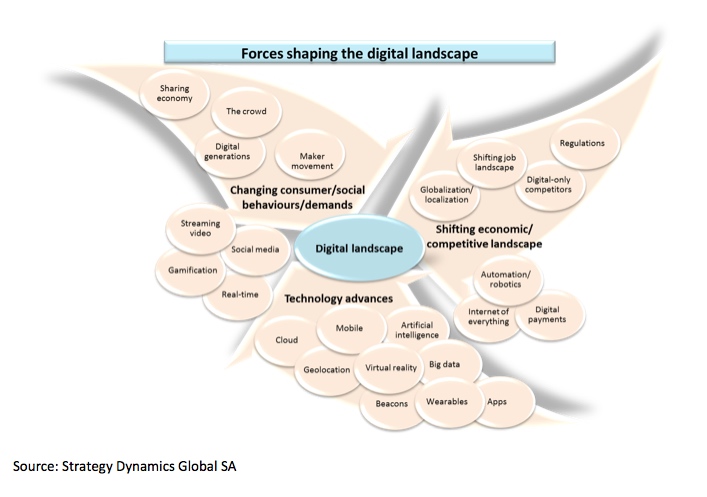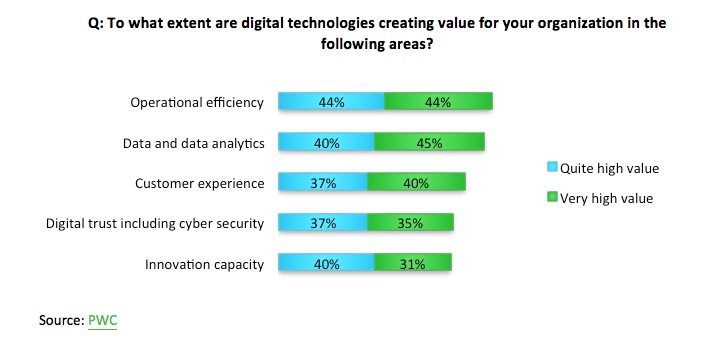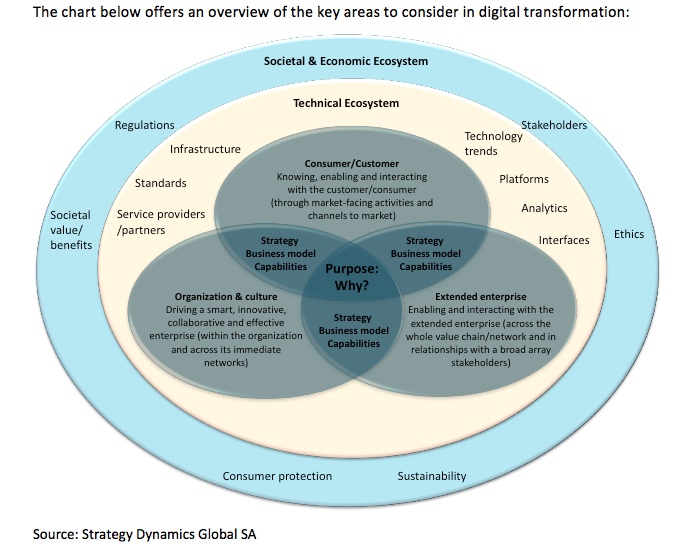June 2015: To go digital or not to go digital? Perhaps the better question, that seems to be on everyone’s mind, is how to go digital? There is such a deluge of opinions, advice, forecasts, predictions and stories available that it would be impossible to do the subject justice in a short monthly briefing. Instead, we are being only slightly less ambitious, offering this first of a three-part briefing on navigating tomorrow’s digital landscape, looking at the challenge from the perspective of businesses. In July and August we will take a look at navigating the digital landscape from a consumer and a government point of view, respectively.
Digitalization (click here to read about the difference between digitalization and digitization) is no longer in its infancy. The adoption of digital technologies, channels and tools is rapidly transforming businesses, industries, communities, governments and consumer lifestyles around the globe. And tech giants, worried that “only” 3.2 billion people are using the internet today (according to latest figures from the ITU), are seeking to bring connectivity to every corner of Earth, via an intriguing mix of balloons, cables and mobile devices. In 2025 we can expect be nearly 5 billion people to be connected to the internet via more than 50 billion connected devices (Source: Microsoft). Digital disruption and transformation is high up the boardroom agenda as it is getting harder to escape technology advancement and the associated data bombardment.
Navigating the digital landscape can be a bumpy and intense ride, but it should also be seen as an opportunity to create advantage. Today’s consumers are so digitally connected and informed that choices can sometimes be overwhelming and opaque. However, more choice means greater power and freedom to influence your life and environment than ever before. For often heavy and bureaucratic governments, digital transformation enables them to make radical steps towards more innovative, agile, cost-effective and citizen-centric systems as well as offering new ways to deliver public services. For businesses, navigating the digital landscape is a race, a race to win in new markets and disrupt existing ones.
Disruption points can be hard to identify. However, analysing macro and micro trends, as well as observing changes in other industries can give business leaders a sense of what’s next. Let’s take a look at what is going on in the landscape of digital business.

Businesses in the digital economy
All business leaders worry about the impact of change, but it is unavoidable. In the guise of technology, change is coming faster than ever before, driving innovation and dismantling industry boundaries. For businesses to thrive – and survive – in the digital era it is not a question of adding a few digital upgrades to marketing or organizational strategy, such as integrating Twitter, Facebook or other social media to existing processes.
Instead, businesses must view digital technologies as transformational. They are the source of new and innovative strategies, business models and capabilities that have the potential to create new markets and redefine traditional ones. Organizations that fight, rather than embrace, digital could be at risk. Think the music industry, think Kodak. Most importantly, think differently.
Digital transformation is more than an IT strategy: You don’t have to beFacebook or Apple to be a digital business. Digitalization is a competitive tool that turns digital resources into new sources of growth and revenue – and it most definitely is more than an IT strategy. Many companies treat strategies underpinned by IT in isolation as, e.g. a cloud strategy, a social media strategy or a mobile strategy. Buying a set a new technology tools doesn’t, however, equate to a successful digital transformation. Digitalization, whether externally or internally driven, needs to an integral part of the overall business strategy and transform the business from inside out. (Sources: HBR, Accenture)
Connecting digital investment and business objectives: A recent survey from PWC suggests that CEOs want to see a strong connection between digital investments and business objectives. 86% say a clear vision of how digital technologies can help achieve competitive advantage is key to the success of digital investments. 83% say the same for having a well thought-out plan – including concrete measures of success. But CEOs also know it can’t happen without them: 86% think it’s important that they themselves champion the use of digital technologies.

The increasing importance of digital leadership: As organizations increasingly rely on digital technologies, the demand for digital leadership is growing. It is tempting to believe that hiring a high-flying Chief Digital Officer (CDO) will drive a successful digital transformational process, but it’s not enough. Digital success comes from the very top. Top management must focus on communicating the firm’s digital vision and making it an integral part of all operations in the organization. CIOs, CTOs and CDOs are naturally big buyers of technology and the people that the CEOs turn to today. However, Gartner predicts that CMOs are about to become the largest purchasers of IT as digital marketing is a key priority for investments. (Source: Egon Zehnder)
Rising cross-industry competition: Technology is breaking down industry barriers. Entire industries have already been disrupted, and many more are at risk. Technologically-driven disruption has already made its mark in music, media, travel and retail while other industries, including banking, healthcare, energy and manufacturing, are experiencing similar waves of change. While cross-industry competition may come from many directions, in a recent survey of 1,322 CEOs in 77 countries the technology sector (32%) is seen as emerging or could emerge as a main source of cross-sector competition followed by retail and wholesale distribution (19%), and communication, entertainment and media (16%). (Source: PWC)
For businesses to address the digital era in a transformational way, they need to look at how digital technologies can enhance the value they create and how they capture it on several dimensions:
First, it is important to understand the “why,” i.e. what value will using digital technologies create to help the company deliver on its purpose and address customer/consumer needs? This may include new sources of value, e.g. e-commerce/mobile commerce allowing the company to reduce costs to consumers and to save them time. Once the “why” is clear, the next question is “how” to create, and to capture the potential value.
“How” is about developing the strategies, business models and capabilities required – and about deploying them effectively, within and outside the organization. As noted above, digital transformation often starts with market-facing activities, such as developing new (social media) channels to market and for marketing, but this is not enough. The organization and culture will need to change, as well as internal processes, e.g. to increase speed to market, to collaborate across departments, and to innovate faster. Digital transformation also offers the potential to create and capture value through the extended enterprise or value chain, e.g. through using big data analytics, innovating with suppliers and building relationships with key external stakeholders.
Looking beyond the organization and its immediate interactions with the value chain, channels to market and customers/consumers, there are two further ecosystems to consider when going digital:
The technical ecosystem is evolving rapidly and leaders of the business areas will need to collaborate closely with their technical counterparts to understand the best way to structure technical capabilities and systems both to deliver today and to be able to adapt for the future.
Perhaps the least developed ecosystem is the societal and economic ecosystem. This is where organizations face questions such as: Who owns consumers’ data? How will regulations develop to protect privacy of digital information? What are the implications of e-waste on sustainability goals? As societies and individuals we are still so enamoured with the novelty and potential of digital technologies to improve our lives, health, and more that many of these questions have not yet been asked, let alone answered. However, for businesses pursuing digital transformation, it is important that they have a point of view and take an active role in shaping the answers with relevant stakeholders, as these may have a significant impact on digital strategies and business models in future.

Below we explore examples of how businesses are tackling three of these dimensions: Consumer/customer, organization and culture, and the extended enterprise.
Going digital with the customer/consumer
It’s a wild ride! New digital technologies and platforms have radically changed the way companies and brands communicate with the customer/consumer, and how they in turn interact with organizations and brands. The number of channels to get products and services to market is exploding, along with the number of products and services themselves as, for example, the ability to customize increases and “long tail” becomes economically feasible. Old ways of doing business are no longer sustainable for either B2B or B2C companies. It is easier than ever before for firms and brands to connect directly with their users without expensive middlemen and/or physical channels. The demise of bricks’n’mortar and face to face business dealings and sales is over-hyped, but their roles will change in coming years, as digital and physical market-facing activities increasingly integrate. What won’t change is the need to deeply understand what the customer/consumer wants and needs both from companies and the channels they choose to use.
Trends in action:
Mobile is not an option: By the end of 2015, 42% of the global population will own a smartphone. To stay relevant and keep up with consumer demand it is increasingly important to implement mobile strategies. 57% of consumers will not recommend a business with a poorly designed mobile site. 79% of mobile users will only retry an app once or twice if it failed to work the first time. Users expect mobile apps to load within 3 seconds or less. A connection speed delay of 500 milliseconds raises mobile users’ frustration level by 26%. 30% of mobile shoppers abandon a transaction if the shopping experience is not optimized for mobile. (Source: Payfirma) Have you checked your mobile platform lately?
Innovating the digital way: Nespresso, Porsche and Nike are prime examples of companies that are using digital to expand and innovate their customer engagement activities. Porsche uses its customer data to keep its processes and services agile by bringing together real-time marketing and predicative analytics, e.g. customer intelligence data is instantly accessible across the entire organization. In the quest to offer its customers the perfect coffee experience, Nespresso is using an innovative cloud-based platform to handle the entire buying process. It uses the platform to pull consumer information from external sources, e.g. social media, and then directly engages with its customers, an approach it calls “a segment of one.” Nike’s Nike+ community is a great example of using digital co-creation/collaboration to develop and sustain long-term relationships with its customers. Nike gets valuable information about its customers and its products while its users can share and suggest runs, exchange comments, post information, interact with friends etc. – a classic win-win situation. (Sources: ZDNet, Forbes)
Look out for:
Programmatic branding: Programmatic branding is an exciting new way to use digital technology for direct-response advertising. By using automated advertising it is possible to cherry-pick the consumers that marketers wants to see their ads. Digital data, tied to consumer segments and internet behaviour, makes it possible for marketers to select precisely what they want to buy for a campaign. Consumer packaged goods brands such as Nestlé, Kimberly-Clark, Kellogg’s and Oreo have already fully embraced the technology. Oreo made history by being the first company to buy a Super Bowl spot through programmatic technology and Nestlé recently successfully delivered 91% of ads to new visitors with high viewability. (Sources: The Programmatic Mind, Ad Exchanger)
The consumerization of B2B: Traditionally, the B2B sales process has involved a sales representative. However, with increasingly easy access to information and self-service portals, the role of the traditional B2B salesperson is becoming less important. Forrester believes that out of the 4.5 million US salesperson jobs today one million jobs will be displaced by 2020. While complex and expensive buying activities will likely continue to need a sales rep, digital channels are changing the B2B ecosystem. Nearly 75% of B2B buyers say that buying from a website is more convenient than buying from a sales representative. 93% say that they prefer buying online rather than from a salesperson when they’ve decided what to buy. If B2B companies wait too long to create self-serve e-commerce websites they risk losing business to more forward-thinking competitors. (Source: Forbes)
Examples of companies embracing digital transformation
Technology is no longer only for the early adopters and certainly not something to be left for the future. Many businesses have, of course, already taken steps towards digital transformation, a continuous journey that will be influenced by future technology advances. Some business are using partners to advance and excel in the digital journey while others are managing to work through the transformation on their own. However, many others are still trying to find their way. Dan Ariely of Duke University’s quote about big data could certainly equally be applied to digital transformation: “Big data [digital transformation] is like teenage sex: everyone talks about it, nobody really knows how to do it, everyone thinks everyone else is doing it, so everyone claims they are doing it.”The companies below could be a good place to start for some lessons on how to move forward.
Managing the extended enterprise:
Swisscom exploring role of digitalization and IoT on future mobility: Trials with driverless car are hitting the road worldwide. Switzerland is no exception and the country’s biggest ICT provider is making it happen. For Swisscom, this adventure with the car industry is an exploration of how the internet of things (IoT) can change society, rather than a move into making cars. According to Christian Petit, Head of Swisscom Enterprise Customers, “Swisscom is not turning into a car manufacturer. But future innovations in the automotive industry will center on networking with the environment. For this reason, the driverless car is a primeexample of digitization and therefore of great interest to us.” (Source: Mobile Europe)
Technica Group/Blizzard: In the good old days it didn’t matter that it took 2-3 weeks to manufacture a pair of skis as retailers would place their order many months in advance. However, when skiers started to rent skis instead of buying them, to take advantage of new types of skis for specific purposes such as powder and to improve convenience, it disrupted ski manufacturing. Two-thirds of the buyers disappeared and too many skis went unsold. Something had to be done. The first step for ski manufacturer Technica Group, which makes Blizzard skis, was to follow in the footsteps of the car industry, going lean by reducing inventory and optimizing production with help from consultants from Porsche. The second big change was starting to use data analytics. Data was captured from production and combined with data flows from outside the factory, e.g. weather forecasts, commodities prices, and ski trends, to build a more accurate production forecast. It managed to cut production risk from 95% to close to 0% and lead-time shrank from months to weeks. (Source: IBM)
Elemental Path: The toy industry is extremely competitive and hit-driven. But that has not deterred firms outside the toy industry from aiming to change the way kids learn and play with the help of technology. Using technology in children’s toys is certainly not new. However, the invention CogniToys, huge hit at the American International Toy fair in New York, is different from other technology-empowered toys. A toy dinosaur, it is connected to the cloud and powered by IBM’s Watson (an artificially intelligent computer system capable of answering questions posed in natural language) – its connected networks allows it to be updated in real-time, and answer questions like why is the sky blue or how far away is the moon. A demonstration how a new breed of entrepreneurs could potentially disrupt even the toughest industries. (Source: IBM)
Driving a digital organization & culture:
Marriott: Marriott, a worldwide leader in the hospitality industry, is now using networks and collaboration among its employees throughout its 15 brands. Through digital transformation the hotel chain has tapped into the capacities of mobile technology and sharing knowledge digitally is central to its strategy. It has ultimately helped the brand to improve business practices and customer satisfaction. During the digital transformation process Marriott realized that technology is a critical part of all changes and the organization has now positioned itself to be agile and ready to adapt to future emerging technologies. (Source: ZDNet)
T-Mobile US: The American phone service operator T-Mobile has focused its digital transformation on becoming more customer-centric. This has meant fundamental changes throughout the organization. In addition to its IT department, T-Mobile has made changes to marketing, customer service and sales. Today, the IT department is faster, smarter and more automated. The customer experience is personalized with targeted offers and content drawn from high-speed analysis of each customer’s attributes. Marketing campaigns use a CRM-integrated media management network so outside marketing agencies can log on to see what T-Mobile’s marketing department needs. Some of the benefits of these changes include shortened training times (three months to four days), a 15% increase in customer engagement productivity, and faster resolution times. Now, T-Mobile has the ability to act before a customer is lost, and sharing information is the key. (Source: ZDNet)
BBVA: Recently appointed, BBVA chairman and CEO Francisco Gonzalespredictsabout half of the world’s banks will disappear because of digital disruption in the industry. He believes that the banking industry is under threat from the big internet players, e.g. Google, Facebook, Amazon and even start-ups. To respond to that threat, something all banks should do, Gonzales has an ambition of transforming BBVA into the first truly global digital bank by reinventing the bank as a knowledge-based information company and a pure digital house. According to Gonzales the digital problem for banks is that: “Most banks look only at the rooftop – the products and services that customers see. The problem is if you only build the rooftop, and don’t change the structure underneath, the whole building becomes very unstable.” That is why BBVA is building a completely new technology platform. Standalone front-end features and applications are not sufficient. Crucial changes to the underlying technology platform, process, data assets, and staff skills must also be addressed and changed. (Source: EuroMoney)
In July: Look out for trends in action on Navigating tomorrow’s digital landscape Part 2: Consumers




